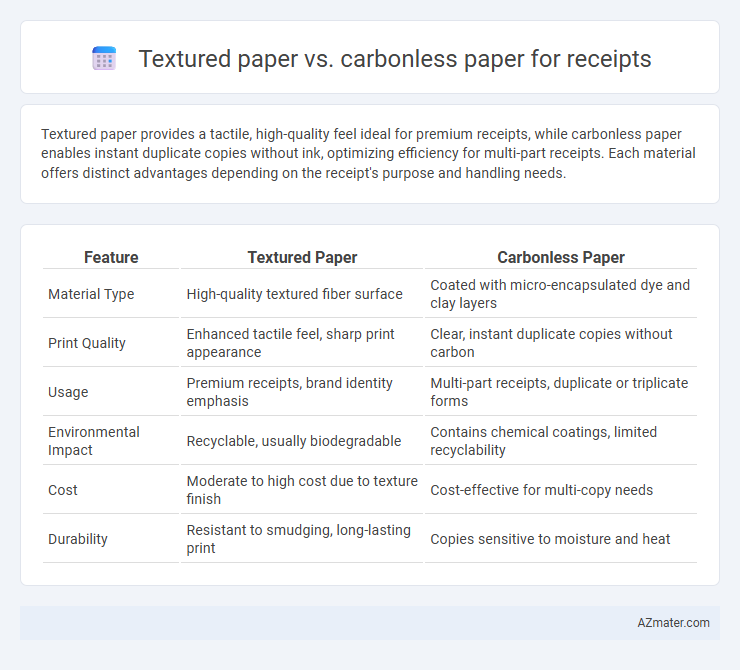Textured paper provides a tactile, high-quality feel ideal for premium receipts, while carbonless paper enables instant duplicate copies without ink, optimizing efficiency for multi-part receipts. Each material offers distinct advantages depending on the receipt's purpose and handling needs.
Table of Comparison
| Feature | Textured Paper | Carbonless Paper |
|---|---|---|
| Material Type | High-quality textured fiber surface | Coated with micro-encapsulated dye and clay layers |
| Print Quality | Enhanced tactile feel, sharp print appearance | Clear, instant duplicate copies without carbon |
| Usage | Premium receipts, brand identity emphasis | Multi-part receipts, duplicate or triplicate forms |
| Environmental Impact | Recyclable, usually biodegradable | Contains chemical coatings, limited recyclability |
| Cost | Moderate to high cost due to texture finish | Cost-effective for multi-copy needs |
| Durability | Resistant to smudging, long-lasting print | Copies sensitive to moisture and heat |
Introduction to Receipt Paper Types
Textured paper for receipts offers a tactile surface that enhances ink absorption and durability, making it ideal for handwritten or printed receipts that require a premium feel. Carbonless paper, often used for multi-part receipts, replicates writing on original sheets without carbon sheets, enabling instant duplicate copies essential for record-keeping and transaction verification. Selecting between textured and carbonless paper depends on the need for physical copy quality versus efficient multi-copy functionality in retail and service environments.
What is Textured Paper for Receipts?
Textured paper for receipts features a tactile surface that enhances grip and adds a premium feel, making it ideal for luxury retail or boutique businesses. Unlike carbonless paper, which chemically transfers writing from one sheet to another to create duplicates, textured paper focuses on aesthetic appeal and durability. This type of paper often provides better ink absorption for clearer, more vibrant printing on receipts.
What is Carbonless Paper for Receipts?
Carbonless paper for receipts is a special type of paper designed to create instant duplicates without the need for carbon sheets, utilizing micro-encapsulated dye or ink that activates under pressure. This technology ensures clean, smudge-free copies, making it ideal for multi-part receipt systems in retail and service industries. Compared to textured paper, which is valued for its tactile feel and aesthetic appeal, carbonless paper emphasizes functionality and efficiency in record-keeping and transaction verification.
Key Differences Between Textured and Carbonless Papers
Textured paper offers a tactile, premium feel ideal for upscale receipts, while carbonless paper is designed for creating instant duplicates without carbon sheets, essential for multi-part forms. The main difference lies in texture and purpose: textured paper enhances brand perception with its unique surface, whereas carbonless paper emphasizes functionality by transferring handwritten or printed information across layers. Durability and environmental impact also vary, with carbonless paper often containing chemical coatings that may affect recyclability, unlike many textured paper options made from natural fibers.
Print Quality Comparison: Textured vs Carbonless Paper
Textured paper offers superior print quality for receipts by enhancing ink absorption and producing sharp, vivid text and images that resist smudging. Carbonless paper, while convenient for multi-part forms, often results in faded or less defined prints due to its chemical coating, which can compromise clarity over time. Choosing textured paper ensures more durable and professional-looking receipts, especially for businesses prioritizing presentation and legibility.
Durability and Longevity of Receipts
Textured paper for receipts offers enhanced durability due to its thicker fibers and resistance to smudging, making it ideal for long-term record-keeping. Carbonless paper, while convenient for multi-part receipt copies, tends to degrade faster as the micro-encapsulated dyes can fade over time, reducing legibility. For businesses seeking durable and long-lasting receipts, textured paper provides superior longevity compared to carbonless options.
Cost Implications: Textured vs Carbonless Paper
Textured paper generally incurs higher costs due to its complex manufacturing process and premium materials, making it less cost-effective for high-volume receipt printing. Carbonless paper offers a more economical solution by eliminating the need for carbon sheets while enabling multi-part forms, reducing overall expenses in receipt duplication. Businesses seeking budget-friendly options often prefer carbonless paper for its combination of functionality and cost efficiency in receipt production.
Environmental Impact and Sustainability
Textured paper for receipts is often made from recycled fibers and is biodegradable, reducing landfill waste and promoting eco-friendly disposal. Carbonless paper typically contains chemical coatings that may hinder recyclability and introduce pollutants during breakdown, negatively impacting environmental sustainability. Choosing textured paper supports greener practices by minimizing chemical use and enabling easier recycling, aligning with sustainable business operations.
Best Use Cases for Each Paper Type
Textured paper provides a premium tactile experience ideal for luxury retail receipts, invitations, and business cards where a sophisticated appearance enhances brand perception. Carbonless paper excels in multi-copy receipt printing for restaurants, delivery services, and invoices, enabling immediate duplicate records without the use of ink ribbons or carbon sheets. Choosing textured paper suits high-end customer interactions, while carbonless paper is optimal for efficient, multi-part documentation requiring quick duplication.
Choosing the Right Receipt Paper for Your Business
Textured paper offers a high-quality feel and enhanced durability, ideal for businesses seeking an upscale customer experience, while carbonless paper provides efficient, multi-copy receipts essential for transactions requiring duplicate records. Choosing the right receipt paper depends on business needs such as customer interaction style, environmental considerations, and record-keeping requirements. Evaluating factors like print quality, cost-effectiveness, and compatibility with your POS system ensures optimal selection between textured and carbonless receipt papers.

Infographic: Textured paper vs Carbonless paper for Receipt
 azmater.com
azmater.com